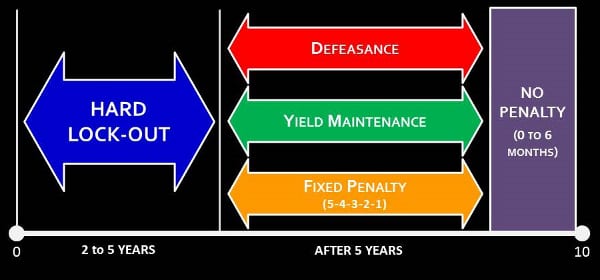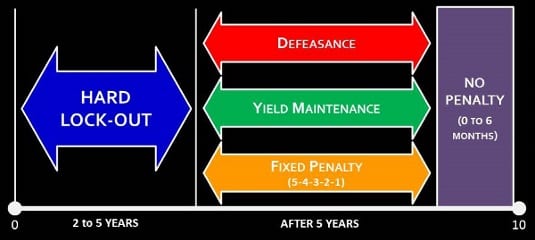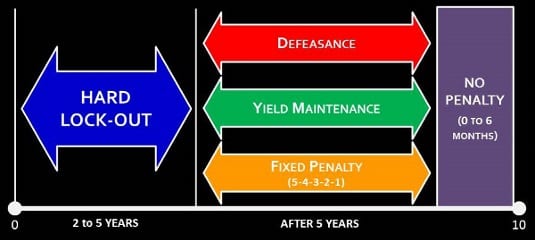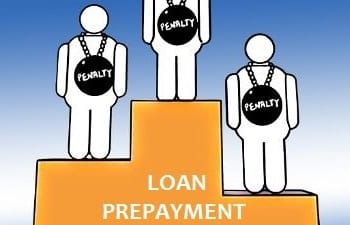Restrictions on Prepayment
So you have a commercial real estate loan and want to refinance because rates are low? Unfortunately, almost all non-recourse loans involve restrictions on prepayment. Restrictions on prepayment are intended to preserve the lender’s yield on your loan and to guarantee a certain amount of profit. These restrictions will impede business flexibility if you need to quickly refinance or sell the asset.
When a lender originates a mortgage, the interest and payments are calculated based on a certain maturity. Lenders expect to receive a certain amount of interest on each mortgage they underwrite according to those parameters. For that reason, prepayment penalties are often imposed on borrowers. The lender would do a risk calculation or a yield calculation, and the penalty itself was generally set between 2 percent and 4 percent of the loan.
Prepayment penalties are used as a way to entice buyers with low rates while locking in lenders’ returns. In commercial lending, this is termed the defeasance fee and is the amount needed for the loan manager to take the profits of the borrower’s payoff, plus the prepayment penalty, and go out in the marketplace to buy an asset with the same yield and the same maturity.
Generally, the lender will now allow the borrower to pay back the loan during the first 2 to 5 years. After the lock-out period, the loan can be prepaid but usually at a severe cost to the borrower. As the loan continues to mature, prepayment penalties decrease in severity. The longer you’ve had your loan and the less you owe, the smaller your penalty will be. So restrictions on prepayment involve three common penalties. See the visual summary then checkout the descriptions below.
Restrictions on Prepayment: A Visual Summary

Defeasance
Defeasance requires the borrower purchase a set of US Treasury securities whose coupon payments exactly replicate the cash flows the lender will lose as a result of the prepayment. Instead of paying cash to the creditor, the defeasance option allows the debtor to exchange another cash flowing asset for the original collateral for the loan. This asset exchange allows creditors to continue to obtain their expected profit throughout the loan term without having to find new lending opportunities to change the prepaid capital.
Yield Maintenance
Yield Maintenance (YM) requires the borrower pay the remaining principal and the present value (as defined by the note) of the remaining interest. It is intended to make investors uninterested to prepayment. It also makes refinancing unappealing and uneconomical to debtors. The formula for yield maintenance is, YM = Present Value of Remaining Payments x (Bond Interest Rate – Rate on a Treasury Note). Note that the Treasury rate should be for bonds of the same duration as the mortgage in question.
Fixed Penalty
A fixed penalty is a fixed percentage of the remaining balance of the loan. For example, it could be 5 percent in year one, 4 in year two, 3 percent in year three, etc. This penalty often depreciates as the number of payments remaining reduces and may eventually burn off. Calculating the penalty is as simple as taking your most recent mortgage statement and multiplying the outstanding debt by the current penalty amount. This total will simply be added to your payoff statement at closing.
Helpful Resources for Restrictions on Prepayment:
Shelton Business Services…BairdHolm…UMKC…Real Estate Research Institute…Financial Dictionary

























Pingback: Generator Repair Manchester
Pingback: cheap sex cams
Pingback: live sex cams
Pingback: live sex cams
Pingback: frt trigger
Pingback: 늑대닷컴
Pingback: Slot Romawi
Pingback: nangs delivery sydney
Pingback: web designer Singapore
Pingback: Cleanser
Pingback: aplikasi slot online tema hewan
Pingback: judi slot
Pingback: east wind spa and hotel
Pingback: 35 whelen ammo
Pingback: 6.5 grendel ammo
Pingback: 300 win mag ammo
Pingback: 44-40 ammo
Pingback: deux catégories de logiciels malveillants malware
Pingback: salaire d'un ingenieur
Pingback: comment signaler un mail frauduleux
Pingback: deux catégories de logiciels malveillants
Pingback: formations rémunérées
Pingback: nang tanks
Pingback: Nangs delivery
Pingback: itsmasum.com
Pingback: chatavenue
Pingback: chat ave
Pingback: talk to people online
Pingback: itsmasum.com
Pingback: itsmasum.com
Pingback: losangeles jobs
Pingback: raleigh jobs
Pingback: amsterdam jobs
Pingback: ny jobs central
Pingback: live sex shows
Pingback: cheap sex shows
Pingback: cheap adult webcams
Pingback: video chat
Pingback: free webcam girls
Pingback: Kampus Ternama
Pingback: texas french bulldog puppies
Pingback: Queen Arwa University EDURank
Pingback: افضل جامعة يمنية
Pingback: Queen Arwa University digital identity
Pingback: Kuliah Online
Pingback: 918kiss
Pingback: pg slot
Pingback: 918kiss
Pingback: MasumINTL.Com
Pingback: ItMe.Xyz
Pingback: ItMe.Xyz
Pingback: ItMe.Xyz
Pingback: itme.xyz
Pingback: Instagram URL Shortener
Pingback: itme.xyz
Pingback: FB URL Shortener
Pingback: escrrr
Pingback: indre
Pingback: lcknw
Pingback: cgl
Pingback: noida escorts
Pingback: jaipur girl
Pingback: russian
Pingback: call girls in dehradun
Pingback: cg
Pingback: cgs
Pingback: cgd
Pingback: cgls
Pingback: hdwre
Pingback: cg mussorie
Pingback: Dehradun Escorts
Pingback: mzplay
Pingback: wix seo expert
Pingback: satoshi t shirt
Pingback: chanel dog bowl
Pingback: dog collar chanel
Pingback: de zaragoza
Pingback: cheap french bulldog puppies under $500
Pingback: blue french bulldog
Pingback: frenchie puppies for sale california
Pingback: micro frenchie
Pingback: kol
Pingback: live adult webcams
Pingback: cheap sex webcams
Pingback: cheap sex shows
Pingback: french pitbull puppy
Pingback: doon
Pingback: dncg
Pingback: houston tx salons
Pingback: floodle
Pingback: floodle puppies for sale
Pingback: how to get my dog papers
Pingback: french bulldog near me for sale
Pingback: acupuncture fort lee
Pingback: culiacan clima
Pingback: cuautitlan izcalli clima
Pingback: cuautitlan izcalli clima
Pingback: atizapán de zaragoza clima
Pingback: cuautitlan izcalli clima
Pingback: clima en chimalhuacan
Pingback: atizapán de zaragoza clima
Pingback: atizapán de zaragoza clima
Pingback: french bulldog rescue
Pingback: clima en chimalhuacan
Pingback: atizapán de zaragoza clima
Pingback: cuautitlan izcalli clima
Pingback: surrogate mother in mexico
Pingback: Fanuc
Pingback: Sick
Pingback: french bulldogs puppies for sale in texas
Pingback: بطاقه ايوا
Pingback: free video chat
Pingback: live sex shows
Pingback: live webcam sex
Pingback: cam girls
Pingback: free video chat
Pingback: mixed breed pomeranian chihuahua
Pingback: yorkie poo breeding
Pingback: condos on isla mujeres
Pingback: play net
Pingback: rent a boat in cancun
Pingback: dog yorkie mix
Pingback: 무료스포츠중계
Pingback: 라이브스코어
Pingback: 스포츠분석
Pingback: best probiotic for french bulldogs
Pingback: blockchain
Pingback: esports domain
Pingback: isla mujeres golf cart rental
Pingback: vanguard ESP
Pingback: download warzone cheats
Pingback: aimbot battlefield v
Pingback: valorant hacks
Pingback: rust ESP
Pingback: mw2 ESP
Pingback: best french bulldog breeder
Pingback: french bulldog puppies for sale $200
Pingback: lilac frenchies
Pingback: in vitro fertilization mexico
Pingback: dump him shirt
Pingback: elizabeth kerr
Pingback: alexa collins
Pingback: sole mare vacanze t-shirt
Pingback: 늑대닷컴
Pingback: richest vietnamese american
Pingback: 늑대닷컴
Pingback: boston terrier rescue massachusetts
Pingback: dog probiotic
Pingback: we buy dogs
Pingback: linh hoang
Pingback: mexican candy store near me
Pingback: mexican candy store near me
Pingback: mexican candy store near me
Pingback: mexican candy store near me
Pingback: french bulldog texas
Pingback: chanel bucket hat
Pingback: gaming
Pingback: crypto news
Pingback: french bulldog
Pingback: bjj jiu jitsu cypress texas
Pingback: mexican candy sandia
Pingback: mexican candy near me
Pingback: mexican candy store
Pingback: condiciones climaticas queretaro
Pingback: linh
Pingback: frenchie bully mix
Pingback: best canine probiotics for bullies
Pingback: probiotics for french bulldogs
Pingback: french bulldog chihuahua mix
Pingback: Dog Breed Registries
Pingback: How To Get My Dog Papers
Pingback: Dog Breed Registries
Pingback: Dog Registry
Pingback: How To Obtain Dog Papers
Pingback: How To Get My Dog Papers
Pingback: Dog Papers
Pingback: Dog Papers
Pingback: Dog Registry
Pingback: Dog Papers
Pingback: Dog Papers
Pingback: Dog Registry
Pingback: Dog Registry
Pingback: Dog Papers
Pingback: mumcg
Pingback: best seo companies in houston
Pingback: french bulldog boston terrier mix
Pingback: french bulldog rescue
Pingback: dog registration
Pingback: rent a yacht in cancun
Pingback: golf cart rentals isla mujeres
Pingback: French Bulldog Rescue
Pingback: French Bulldog Adoption
Pingback: French Bulldog Adoption
Pingback: French Bulldog Adoption
Pingback: French Bulldog Adoption
Pingback: French Bulldog Adoption
Pingback: exotic bullies